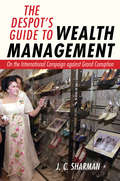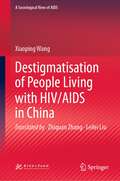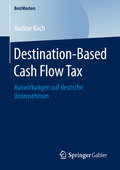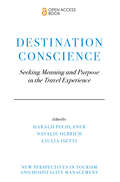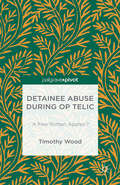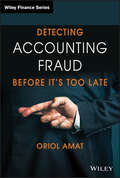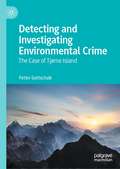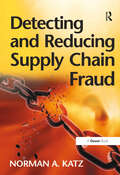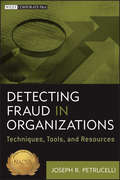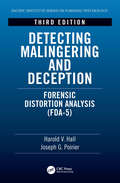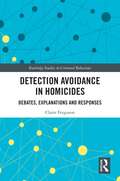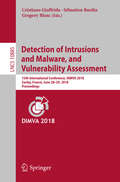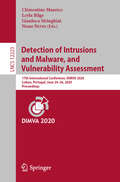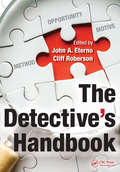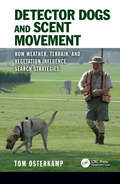- Table View
- List View
The Despot's Guide to Wealth Management: On the International Campaign against Grand Corruption
by J. C. SharmanAn unprecedented new international moral and legal rule forbids one state from hosting money stolen by the leaders of another state. The aim is to counter grand corruption or kleptocracy ("rule by thieves"), when leaders of poorer countries—such as Marcos in the Philippines, Mobutu in the Congo, and more recently those overthrown in revolutions in the Arab world and Ukraine—loot billions of dollars at the expense of their own citizens. This money tends to end up hosted in rich countries. These host states now have a duty to block, trace, freeze, and seize these illicit funds and hand them back to the countries from which they were stolen. In The Despot's Guide to Wealth Management, J. C. Sharman asks how this anti-kleptocracy regime came about, how well it is working, and how it could work better. Although there have been some real achievements, the international campaign against grand corruption has run into major obstacles. The vested interests of banks, lawyers, and even law enforcement often favor turning a blind eye to foreign corruption proceeds. Recovering and returning looted assets is a long, complicated, and expensive process.Sharman used a private investigator, participated in and observed anti-corruption policy, and conducted more than a hundred interviews with key players. He also draws on various journalistic exposés, whistle-blower accounts, and government investigations to inform his comparison of the anti-kleptocracy records of the United States, Britain, Switzerland, and Australia. Sharman calls for better policing, preventative measures, and use of gatekeepers like bankers, lawyers, and real estate agents. He also recommends giving nongovernmental organizations and for-profit firms more scope to independently investigate corruption and seize stolen assets.
Destigmatisation of People Living with HIV/AIDS in China (A Sociological View of AIDS)
by Xiaoping WangAfter reviewing related theories on stigmatisation of people living with HIV/AIDS (PLWHA), this book applies social exclusion theory, actor theory and stigma theory to the study of social mechanisms of stigmatisation of PLWHA in China to show the influence and mechanism of stigmatisation on them, and tries to construct the policy framework to tackle stigmatisation from the perspective of welfare pluralism. Qualitative analysis was used and data was obtained during the field interview. Thirty PLWHA and seventeen healthy people (non-infected people and staff of ASO Service Organizations) were selected by using random sampling and snowball sampling for semi-structured depth interviews. The research examines the treatments and living conditions of those PLWHA, aiming to explore the influence of HIV on them in education, employment, medical care, economy, welfare and social relations. The book is intended for graduate students, researchers interested in this field and relevant policymakers.
Destination-Based Cash Flow Tax
by Nadine KochNadine Koch legt ihrer Untersuchung den Vorschlag zugrunde, die Unternehmensbesteuerung am Konzept einer Destination-Based Cash Flow Tax (DBCFT) mit Spezifikation eines Grenzsteuerausgleichs auszurichten und analysiert die Auswirkungen bei einer unilateralen Implementierung in einem Drittland. Als Ergebnis kann die Autorin für global agierende Unternehmen Wettbewerbsverzerrungen durch Doppel- und Nichtbesteuerungen feststellen. Die Analyse der DBCFT umfasst eine steuersystematische Einordnung der Modellkomponenten sowie die ökonomischen und steuerlichen Auswirkungen eines Grenzsteuerausgleichs. Zusätzlich erfolgt eine Untersuchung jener steuersystematischen Einordnung der DBCFT auf ihre Kompatibilität mit den derzeitigen Rechtsrahmen im globalen, zwischenstaatlichen und europäischen Kontext. Aus den Untersuchungsergebnissen werden Handlungsempfehlungen für deutsche Unternehmen abgeleitet.
Destination Conscience: Seeking Meaning and Purpose in the Travel Experience (New Perspectives in Tourism and Hospitality Management)
by HARALD PECHLANER, NATALIE OLBRICH AND GIULIA ISETTIThe ebook edition of this title is Open Access and freely available to read online. In a fast paced and increasingly digital world, a higher degree of sensitivity, humaneness and care in dealing with each other and in addressing feelings of isolation, alienation and fear is necessary. Within this context, the realm of tourism stands as no exception. This edited collection defines the new concept of Destination Conscience within the domain of tourism. It sheds light on the growing need for authenticity, meaning and a "human path" on the visitors’ side, and the ability to develop such sensitivity on the destinations’ side in creating meaning and responsibility. Whether through spirituality, religion, nature, history, or the subtleties of daily life, this novel paradigm fosters destinations' capacities to create meaning-driven experiences for their guests. In addition to outlining and defining the new concept of destination conscience, the inter-disciplinary approach and selected case studies and illustrative examples make Destination Conscience attractive to a variety of readers including researchers, practitioners, and postgraduate students in the fields of tourism management, spiritual and religious tourism, social sustainability, human and urban geography.
Destination Conscience: Seeking Meaning and Purpose in the Travel Experience (New Perspectives in Tourism and Hospitality Management)
by Harald Pechlaner Natalie Olbrich Giulia IsettiThe ebook edition of this title is Open Access and freely available to read online. In a fast paced and increasingly digital world, a higher degree of sensitivity, humaneness and care in dealing with each other and in addressing feelings of isolation, alienation and fear is necessary. Within this context, the realm of tourism stands as no exception. This edited collection defines the new concept of Destination Conscience within the domain of tourism. It sheds light on the growing need for authenticity, meaning and a "human path" on the visitors’ side, and the ability to develop such sensitivity on the destinations’ side in creating meaning and responsibility. Whether through spirituality, religion, nature, history, or the subtleties of daily life, this novel paradigm fosters destinations' capacities to create meaning-driven experiences for their guests. In addition to outlining and defining the new concept of destination conscience, the inter-disciplinary approach and selected case studies and illustrative examples make Destination Conscience attractive to a variety of readers including researchers, practitioners, and postgraduate students in the fields of tourism management, spiritual and religious tourism, social sustainability, human and urban geography.
Detainee Abuse During Op TELIC: ‘A Few Rotten Apples’?
by Timothy WoodThis book reviews the nature of the alleged abuse committed by the UK military forces, exploring the legal paradigm in which the abuse allegedly occurred; the morality of those accused; and the robustness of the accusation of a 'policy of abuse'.
Detecting Accounting Fraud Before It's Too Late (The Wiley Finance Series)
by Oriol AmatDetect accounting fraud before it’s too late Accounting fraud is the deliberate manipulation of accounting records in order to make a company's financial performance seem better or worse than it actually is. Accounting scandals often have catastrophic consequences for shareholders and employees. Thus, analysts and auditors must be equipped to detect accounting fraud. This book is a comprehensive guide to detecting accounting fraud for auditors investigating accounting fraud and analysts/managers seeking to prevent it. A wide variety of warning signs are described, as are several techniques for detecting and addressing fraud. Understand the motivations and warning signs behind accounting fraud Get to know how accounting fraud is done and how to detect it Avoid the losses that often come from accounting fraud Benefit from case studies throughout to that help illustrate the author's points It’s unfortunate that managers, auditors, and analysts must be wary of accounting fraud—but this book equips you with the know-how to detect it before it’s too late.
Detecting Accounting Fraud Before It's Too Late (The Wiley Finance Series)
by Oriol AmatDetect accounting fraud before it’s too late Accounting fraud is the deliberate manipulation of accounting records in order to make a company's financial performance seem better or worse than it actually is. Accounting scandals often have catastrophic consequences for shareholders and employees. Thus, analysts and auditors must be equipped to detect accounting fraud. This book is a comprehensive guide to detecting accounting fraud for auditors investigating accounting fraud and analysts/managers seeking to prevent it. A wide variety of warning signs are described, as are several techniques for detecting and addressing fraud. Understand the motivations and warning signs behind accounting fraud Get to know how accounting fraud is done and how to detect it Avoid the losses that often come from accounting fraud Benefit from case studies throughout to that help illustrate the author's points It’s unfortunate that managers, auditors, and analysts must be wary of accounting fraud—but this book equips you with the know-how to detect it before it’s too late.
Detecting and Investigating Environmental Crime: The Case of Tjøme Island
by Petter GottschalkThis book discusses environmental crime and individual wrongdoing. It uses the theory of convenience throughout to examine financial motives, attractive opportunities, and personal willingness to explain deviant behavior. This book focusses primarily on the case study of the Island of Tjøme in Norway, an attractive resort where building permits were repeatedly granted to rich people in a protected zone along the shoreline. This book investigates how these crimes were detected and investigated by police over a few years with the help of whistleblowers. It discusses the interplay between the potentially corrupt public officials, professionals like architects and attorneys, and rich individuals, as an interesting and challenging arena for law enforcement. It covers attorneys’ defense strategies, evaluates private internal policing, and provides insights for those investigating individuals involved in environmental crime. It also examines the Vest Tank toxic waste dumping case and the resulting explosion where unusually both the chairperson and the chief executive were successfully sentenced to prison because of environmental crime, unlike many other environmental crime cases where individuals avoid prison. The case studies are drawn from Norway to supplement more well-known case studies from the USA.
Detecting and Reducing Supply Chain Fraud
by Norman A. KatzNorman Katz has secured a top spot as one of the Top 50 Global Thought Leaders and Influencers on Supply Chain 2020. For most large organizations, the supply chain is a commercial advantage, enabling innovation, cost management and resilience. But the supply chain is open to fraud: the length and complexity of it creates opportunities for fraudsters to exploit phantom inventory, invent non-existent customers or suppliers, substitute one product for another, cheat on the quality...this list goes on. These frauds present a significant source of additional cost to the organization and expose it to a host of secondary risks: contract, compliance and reputation. Detecting and Reducing Supply Chain Fraud is a pragmatic guide to identifying and managing sources of risk. Norman A. Katz explains the main categories of fraud risk: what they are, what is their significance and how they are exploited by the fraudster. He also explores both the tactical and strategic approaches that you should adopt to help detect and reduce fraud, including detection techniques and the use of technology. He provides tactics for increasing your organization's resilience: increased transparency, appropriate governance, and engaging employees, customers and suppliers in more ethical work practices. If you are responsible for your organization's supply chain, or perhaps involved in audit, compliance or risk management, start using Detecting and Reducing Supply Chain Fraud and look more closely at every aspect of your supply chain, both internal and external. The savings made in fraud reduction, the increased resilience you will give all of your operations and the improved reputation that your business will enjoy, as a contract partner or amongst stakeholders, will repay your investment a hundred-fold.
Detecting and Reducing Supply Chain Fraud
by Norman A. KatzNorman Katz has secured a top spot as one of the Top 50 Global Thought Leaders and Influencers on Supply Chain 2020. For most large organizations, the supply chain is a commercial advantage, enabling innovation, cost management and resilience. But the supply chain is open to fraud: the length and complexity of it creates opportunities for fraudsters to exploit phantom inventory, invent non-existent customers or suppliers, substitute one product for another, cheat on the quality...this list goes on. These frauds present a significant source of additional cost to the organization and expose it to a host of secondary risks: contract, compliance and reputation. Detecting and Reducing Supply Chain Fraud is a pragmatic guide to identifying and managing sources of risk. Norman A. Katz explains the main categories of fraud risk: what they are, what is their significance and how they are exploited by the fraudster. He also explores both the tactical and strategic approaches that you should adopt to help detect and reduce fraud, including detection techniques and the use of technology. He provides tactics for increasing your organization's resilience: increased transparency, appropriate governance, and engaging employees, customers and suppliers in more ethical work practices. If you are responsible for your organization's supply chain, or perhaps involved in audit, compliance or risk management, start using Detecting and Reducing Supply Chain Fraud and look more closely at every aspect of your supply chain, both internal and external. The savings made in fraud reduction, the increased resilience you will give all of your operations and the improved reputation that your business will enjoy, as a contract partner or amongst stakeholders, will repay your investment a hundred-fold.
Detecting Fraud in Organizations: Techniques, Tools, and Resources (Wiley Corporate F&A)
by Joseph R. PetrucelliA savvy examination of where people and value meet, creating the opportunity for fraud An essential reference for all business professionals, Detecting Fraud in Organizations: Techniques, Tools, and Resources explains the process of how people commit fraud, as well as how to prevent and stop fraud from occurring in your organization. Organized by business processes which succinctly describe how fraud manifests itself on a daily basis, the authors explain ways in which everyone can help guard against fraud by familiarizing themselves with its building blocks and methods used to perpetrate and conceal it. Filled with situational examples the book is accompanied by a website featuring fraud simulations, business process maps, and other useful tools for combating fraud. Focuses on the people who perpetrate fraud and those who are tasked with preventing and detecting it Uniquely organized by business processes for more relevance and easier understanding by those people working within organizations Shows how subtle factors play a large role in identifying and ferreting out fraud in addition to the traditional knowledge of fraud schemes giving people and organizations the edge they need to be successful in prevention and deterrence Companion website includes additional fraud simulations, business process maps, and useful tools The price of fraud can be devastating to your business. Detecting Fraud in Organizations: Techniques, Tools, and Resources equips you and others in your organization with essential information and tools necessary to proactively catch fraud, reduce losses, improve efficiencies and develop actionable controls.
Detecting Fraud in Organizations: Techniques, Tools, and Resources (Wiley Corporate F&A #644)
by Joseph R. PetrucelliA savvy examination of where people and value meet, creating the opportunity for fraud An essential reference for all business professionals, Detecting Fraud in Organizations: Techniques, Tools, and Resources explains the process of how people commit fraud, as well as how to prevent and stop fraud from occurring in your organization. Organized by business processes which succinctly describe how fraud manifests itself on a daily basis, the authors explain ways in which everyone can help guard against fraud by familiarizing themselves with its building blocks and methods used to perpetrate and conceal it. Filled with situational examples the book is accompanied by a website featuring fraud simulations, business process maps, and other useful tools for combating fraud. Focuses on the people who perpetrate fraud and those who are tasked with preventing and detecting it Uniquely organized by business processes for more relevance and easier understanding by those people working within organizations Shows how subtle factors play a large role in identifying and ferreting out fraud in addition to the traditional knowledge of fraud schemes giving people and organizations the edge they need to be successful in prevention and deterrence Companion website includes additional fraud simulations, business process maps, and useful tools The price of fraud can be devastating to your business. Detecting Fraud in Organizations: Techniques, Tools, and Resources equips you and others in your organization with essential information and tools necessary to proactively catch fraud, reduce losses, improve efficiencies and develop actionable controls.
Detecting Malingering and Deception: Forensic Distortion Analysis (FDA-5) (Pacific Institute Series on Forensic Psychology)
by Harold V. Hall Joseph PoirierDetecting Malingering and Deception: Forensic Distortion Analysis (FDA-5), Third Edition maintains the tradition of the prior two editions, following the Forensic Distortion Analysis (FDA) model. Fully updated since the last edition nearly 20 years ago, the book continues to serve as comprehensive volume on deception and distortion in forensic, clinical and several specialized contexts. As with the previous editions, the book presents a model of deception intended to be utilized and applied by the qualified evaluator. The proposed model covers targets of the faker, response styles show, and methods to detect the deception. The goal is to summarize the historical and latest information on distortion detection, to present guidelines for detecting deception that include variable accuracy rates based on different detection techniques, and to stimulate further research of effective methods of deception detection. Recommendations and guidelines for the practicing clinician are offered throughout the book, including real-world cases to inform and enlighten, particularly in unique cases or those in which the certain outcomes are unexpected. Key Features: Outlines the role of the forensic professional in applying and integrating methods assessment in deception and distortion Provides base-rates for deception-related behavior and events, especially useful in report writing or courtroom testimony as an expert witness Presents the latest advances in methodology and technology to assist in the search for ground truth in applied settings and situations Applies forensic distortion analysis to evaluate the deception-related findings and statements of other professionals involved in a particular case New coverage includes sections and chapters on deception analysis for collectivities, including media groups, contemporary politics, cross-national corporations, conflict, and terrorism Detecting Malingering and Deception incorporates the latest research, providing practical application to utilize information and evaluative methods as they pertain to deception-related settings and situations. Sample reports and extensive graphs, tables, charts, and histograms are provided, and every chapter has been updated with new studies and investigations. The Third Edition boasts six new chapters of coverage to expand the exploration of deception addressing advances in the field, and our current understanding of the phenomenon.
Detecting Malingering and Deception: Forensic Distortion Analysis (FDA-5) (Pacific Institute Series on Forensic Psychology)
by Harold V. Hall Joseph PoirierDetecting Malingering and Deception: Forensic Distortion Analysis (FDA-5), Third Edition maintains the tradition of the prior two editions, following the Forensic Distortion Analysis (FDA) model. Fully updated since the last edition nearly 20 years ago, the book continues to serve as comprehensive volume on deception and distortion in forensic, clinical and several specialized contexts. As with the previous editions, the book presents a model of deception intended to be utilized and applied by the qualified evaluator. The proposed model covers targets of the faker, response styles show, and methods to detect the deception. The goal is to summarize the historical and latest information on distortion detection, to present guidelines for detecting deception that include variable accuracy rates based on different detection techniques, and to stimulate further research of effective methods of deception detection. Recommendations and guidelines for the practicing clinician are offered throughout the book, including real-world cases to inform and enlighten, particularly in unique cases or those in which the certain outcomes are unexpected. Key Features: Outlines the role of the forensic professional in applying and integrating methods assessment in deception and distortion Provides base-rates for deception-related behavior and events, especially useful in report writing or courtroom testimony as an expert witness Presents the latest advances in methodology and technology to assist in the search for ground truth in applied settings and situations Applies forensic distortion analysis to evaluate the deception-related findings and statements of other professionals involved in a particular case New coverage includes sections and chapters on deception analysis for collectivities, including media groups, contemporary politics, cross-national corporations, conflict, and terrorism Detecting Malingering and Deception incorporates the latest research, providing practical application to utilize information and evaluative methods as they pertain to deception-related settings and situations. Sample reports and extensive graphs, tables, charts, and histograms are provided, and every chapter has been updated with new studies and investigations. The Third Edition boasts six new chapters of coverage to expand the exploration of deception addressing advances in the field, and our current understanding of the phenomenon.
Detection Avoidance in Homicide: Debates, Explanations and Responses (Routledge Studies in Criminal Behaviour)
by Claire FergusonDetection Avoidance in Homicides: Debates, Explanations and Responses presents theory and research on how offenders avoid detection and the challenges and opportunities these efforts pose to investigators. From a scholarly perspective, the book presents a continuing history of research on detection avoidance by offenders, discusses the features of complex death investigations involving detection avoidance, and critiques the current frameworks used for conceptualizing these behaviors. Dr. Ferguson focuses on the key debates in the literature, argues for collaborations between researchers and practitioners to remedy siloing, and explores the reality of detection avoidance in homicides as complex and multifaceted. While detection avoidance behaviors have the potential to negatively impact sudden death investigations and frustrate criminal investigations specifically, their use also creates broader problems. These include many problematic effects on family members of the deceased, police officers, police agencies and the communities they serve. Offenders choosing to use detection avoidance behaviors challenges the efficient use of public resources, puts at risk the successful adjudication of homicides, and creates a public safety issue. The book explains detection avoidance using learning, situational, individual and gender-based theories, including proposing whether it may be a form of coercive control used by intimate partner abusers. Finally, how detection avoidance by offenders is recognized and responded to in sudden death investigations is addressed, with specific reference to useful examples of policy reform implemented by various police agencies internationally. Providing research and theory to explain detection avoidance and best practice for responding to it, this book will be of great interest to students and scholars of criminology, forensic science and psychology. It will also be useful to professionals working with homicide offenders.
Detection Avoidance in Homicide: Debates, Explanations and Responses (Routledge Studies in Criminal Behaviour)
by Claire FergusonDetection Avoidance in Homicides: Debates, Explanations and Responses presents theory and research on how offenders avoid detection and the challenges and opportunities these efforts pose to investigators. From a scholarly perspective, the book presents a continuing history of research on detection avoidance by offenders, discusses the features of complex death investigations involving detection avoidance, and critiques the current frameworks used for conceptualizing these behaviors. Dr. Ferguson focuses on the key debates in the literature, argues for collaborations between researchers and practitioners to remedy siloing, and explores the reality of detection avoidance in homicides as complex and multifaceted. While detection avoidance behaviors have the potential to negatively impact sudden death investigations and frustrate criminal investigations specifically, their use also creates broader problems. These include many problematic effects on family members of the deceased, police officers, police agencies and the communities they serve. Offenders choosing to use detection avoidance behaviors challenges the efficient use of public resources, puts at risk the successful adjudication of homicides, and creates a public safety issue. The book explains detection avoidance using learning, situational, individual and gender-based theories, including proposing whether it may be a form of coercive control used by intimate partner abusers. Finally, how detection avoidance by offenders is recognized and responded to in sudden death investigations is addressed, with specific reference to useful examples of policy reform implemented by various police agencies internationally. Providing research and theory to explain detection avoidance and best practice for responding to it, this book will be of great interest to students and scholars of criminology, forensic science and psychology. It will also be useful to professionals working with homicide offenders.
Detection of Intrusions and Malware, and Vulnerability Assessment: 15th International Conference, DIMVA 2018, Saclay, France, June 28–29, 2018, Proceedings (Lecture Notes in Computer Science #10885)
by Cristiano Giuffrida Sébastien Bardin Gregory BlancThis book constitutes the refereed proceedings of the 15th International Conference on Detection of Intrusions and Malware, and Vulnerability Assessment, DIMVA 2018, held in Saclay, France, in June 2018. The 17 revised full papers and 1 short paper included in this book were carefully reviewed and selected from 59 submissions. They present topics such as malware analysis; mobile and embedded security; attacks; detection and containment; web and browser security; and reverse engineering.
Detection of Intrusions and Malware, and Vulnerability Assessment: 17th International Conference, DIMVA 2020, Lisbon, Portugal, June 24–26, 2020, Proceedings (Lecture Notes in Computer Science #12223)
by Clémentine Maurice Leyla Bilge Gianluca Stringhini Nuno NevesThis book constitutes the proceedings of the 17th International Conference on Detection of Intrusions and Malware, and Vulnerability Assessment, DIMVA 2020, held in Lisbon, Portugal, in June 2020.* The 13 full papers presented in this volume were carefully reviewed and selected from 45 submissions. The contributions were organized in topical sections named: vulnerability discovery and analysis; attacks; web security; and detection and containment. *The conference was held virtually due to the COVID-19 pandemic.
Detection of Intrusions and Malware, and Vulnerability Assessment: 14th International Conference, DIMVA 2017, Bonn, Germany, July 6-7, 2017, Proceedings (Lecture Notes in Computer Science #10327)
by Michalis Polychronakis Michael MeierThis book constitutes the refereed proceedings of the 14th International Conference on Detection of Intrusions and Malware, and Vulnerability Assessment, DIMVA 2017, held in Bonn, Germany, in July 2017. The 18 revised full papers included in this book were carefully reviewed and selected from 67 submissions. They present topics such as enclaves and isolation; malware analysis; cyber-physical systems; detection and protection; code analysis; and web security.
Detection of Melt Ponds on Arctic Sea Ice with Optical Satellite Data (Hamburg Studies on Maritime Affairs #25)
by Anja RöselThe Arctic sea ice is characterized by profound changes caused by surface melting processes and the formation of melt ponds in summer. Melt ponds contribute to the ice-albedo feedback as they reduce the surface albedo of sea ice, and hence accelerate the decay of Arctic sea ice. To quantify the melting of the entire Arctic sea ice, satellite based observations are necessary. Due to different spectral properties of snow, ice, and water, theoretically, multi-spectral optical sensors are necessary for the analysis of these distinct surface types. This study demonstrates the potential of optical sensors to detect melt ponds on Arctic sea ice. For the first time, an Arctic-wide, multi-annual melt pond data set for the years 2000-2011 has been created and analyzed.
Detectives Don't Wear Seat Belts: True Adventures of a Female P.I.
by Cici McNairGrowing up in Mississippi, Cici McNair was always more the tomboy her mother supported than the Southern belle her father demanded. She escaped her suffocating upbringing the first chance she had to travel the world. Whether working at the Vatican in Rome or consorting with a gunrunner in Haiti, she lived a life of international adventure. When Cici finds herself in New York, divorced, broke, and fashionably starving to death in a Madison Avenue apartment, she impulsively decides to become a private detective.But, as Cici soon learns, the world of P.I.s is tight-knit and made up almost exclusively of former law enforcement officers. By nature, they are a highly suspicious group and are especially wary of a newcomer with an untraceable past. Diligently working her way through the Yellow Pages, doggedly pursuing the slightest lead, Cici is finally hired by a private investigator willing to take a chance. The next day she's working side by side with a pair of seasoned detectives and a skip tracer who is scary to meet but like silk on the phone. She quickly realizes she'll need all her energy and wits to succeed in this new world.Being a private investigator is as exciting and liberating as Cici ever dreamed, from creating a false identity on the spot on her first case in the field to surviving adrenaline-rushing car chases. Working with law enforcement, she goes undercover, dealing with the ruthless Born to Kill gang in Chinatown and the Middle Eastern counterfeiters west of Broadway. A detailed account of the hidden world and real-life cases of a P.I., this action-packed memoir is as entertaining as any detective novel you've ever read.
The Detective's Handbook
by Cliff Roberson John A. EternoThe Detective‘s Handbook details the vital information law enforcement officers need to know to become better detectives. Since all essential aspects of detective work cannot be covered in a single volume, the editors have selected 20 of the most critical issues detectives face in their day-to-day work and present them in separate chapters.Using a
The Detective's Handbook
by Cliff Roberson John A. EternoThe Detective‘s Handbook details the vital information law enforcement officers need to know to become better detectives. Since all essential aspects of detective work cannot be covered in a single volume, the editors have selected 20 of the most critical issues detectives face in their day-to-day work and present them in separate chapters.Using a
Detector Dogs and Scent Movement: How Weather, Terrain, and Vegetation Influence Search Strategies
by Tom OsterkampDogs detect scent from a source that is carried to them in a plume by the wind. The most important tool for a detector dog handler to have on searches is a knowledge of scent plume movement or "scent dynamics" (the science of scent movement). Such knowledge resides primarily in scientific journals that are largely inaccessible to detector dog handlers and written in language that is difficult to understand. Detector Dogs and the Science of Scent Movement: A Handler’s Guide to Environments and Procedures retrieves, reviews, and interprets the results of pertinent scientific research on scent dynamics and presents these results in terms that are easier for handlers to understand. Information on the physiology of the dog’s nose, their sense of smell, and the properties of scent provide the essential information on the process of scenting. The composition of training aids for explosives, narcotics, human remains and other sources is discussed. Recommendations are made on the use of training aids, their placement during training, and the resulting availability of scent. Potential problems and handler errors in the use of training aids are also examined. The characteristics of scent plumes and how wind influences their movement are a key focus of the book. The primary task for the handler is to get the dog into the scent plume so that the dog can detect the scent and follow it to the source the handler seeks. As such, a knowledge of scent and scent plume movement will vastly improve the ability of the handler to accomplish this task. The influence of weather and physical settings such as terrain, vegetation, ground cover, soil and water on scent movement are examined in detail. Strategies for searching, detecting, and locating sources in all physical settings are presented. Specific effects associated with hills and mountains, fields and forests, bare soils and soils covered by vegetation, different soil types, and lakes and rivers are examined in detail. This includes specific recommendations are made about weather and physical settings that result in higher probability of success on searches. Detector Dogs and the Science of Scent Movement will be a vital resource for K9 handles in the private and public sectors—including in Homeland Security, law enforcement, and military settings—as well as a useful guide for lawyers, forensic, and investigative professionals who need to better understand K9 operations.
